System components
2 SYSTEMS COMPONENTS
2.1 Components for the hen
2.1.1 Feeders
Feed is supplied by means of linear or circular troughs. These are generally well distributed to give easy access. Linear feeders can be either chain feeders, hopper feeders or those with flex auger or other conveyors to transport the feed. The trough can be either inside or outside the area accessible for the bird. If the feeder is outside this area, the hens can use only one side whereas feeders running through the accessible area can be used on both sides. Although the EU-Directive does not mention the latter system for enriched cages circular feeders are applied in FCs as well.
2.1.2 Drinkers
Water is supplied in open water systems or by means of nipple drinkers. Open water systems include bell drinkers and cups of various sizes. Closed water systems include low and high-pressure nipple drinkers. Access to at least 2 nipple drinkers is provided.
2.1.3 Cage gates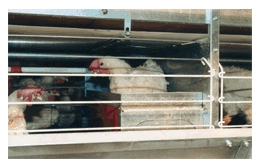 Cage gates are usually constructed of sliding horizontal bars which reduce trapping and feather wear, facilitate easy inspection and improve feed trough access. Fully opening cage gates which allow almost the whole of the cage front above the feed trough to open (except for constructional margins) are now available on most makes of cage (Elson, 1990). Together with gentle handling, this should reduce bone breakage when cages are depopulated.
Cage gates are usually constructed of sliding horizontal bars which reduce trapping and feather wear, facilitate easy inspection and improve feed trough access. Fully opening cage gates which allow almost the whole of the cage front above the feed trough to open (except for constructional margins) are now available on most makes of cage (Elson, 1990). Together with gentle handling, this should reduce bone breakage when cages are depopulated.
FCs often may be equipped with similar cage gates as conventional cages. If feeders are located within the cage, there is no need for horizontal cage gate bars, so other designs sometimes are chosen (e.g. vertical bars or wire mesh).
2.1.4 Claw shorteners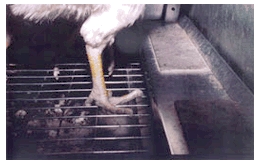 Abrasives are provided in cages to shorten and blunt claws. A wide variety of such devices are now in use. These include perforated egg baffles, ceramic or other stones, abrasive paste, adhesive abrasive strips, abrasive faced metal plates. Some are more effective and durable than others (Elson, 2003).
Abrasives are provided in cages to shorten and blunt claws. A wide variety of such devices are now in use. These include perforated egg baffles, ceramic or other stones, abrasive paste, adhesive abrasive strips, abrasive faced metal plates. Some are more effective and durable than others (Elson, 2003).
Also the effects of the abrasive may vary between different genotypes. The abrasive devices are generally fitted on the baffle plates behind feed troughs. The EU-Directive does not require claw shorteners in alternative systems.
2.1.5 Floors
Most cage floors are constructed of rectangular welded wire mesh of various sizes and galvanised or otherwise treated to give them durability and a smooth finish. This is important to avoid foot and egg damage. Most often the wire mesh is about 50 mm by 25 mm, but 75 mm by 25 mm welded wire or plastic mesh of thicker gauge is sometimes used without apparent foot problems. In alternative systems perforated floors constructed of plastic mesh or slats or of timber slats are in widespread use.
Such floors often incorporate perches under, over or within them – see section on perches. Some FCs also have plastic slats as their floor surface.
The floors usually have a slight slope (max. 8o) so that eggs roll to the front or onto the egg belt. A well-chosen combination of materials, construction and slope is important to prevent foot problems
2.1.6 Perches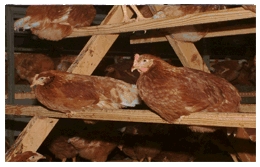 Perches are available in a variety of materials and shapes. Materials used include wood, plastic and metal. They should not have sharp edges. They can be arranged at various heights and positions. In FCs they are usually positioned slightly above the cage floor. If the feed trough is inside the cage, often a perch is positioned on top of it. In alternative systems perches may be located over, within or at the side of the perforated platforms, over feed troughs or on A-frames.
Perches are available in a variety of materials and shapes. Materials used include wood, plastic and metal. They should not have sharp edges. They can be arranged at various heights and positions. In FCs they are usually positioned slightly above the cage floor. If the feed trough is inside the cage, often a perch is positioned on top of it. In alternative systems perches may be located over, within or at the side of the perforated platforms, over feed troughs or on A-frames.
2.1.7 Nest boxes including expulsion systems
Nest boxes include single and colony models. They provide a separate, secluded space for egg laying, to which hens have easy access. The bottom can be lined with various materials, including artificial grass mats, rubber mats, plastic mesh or litter.
To prevent hens from staying in the nest boxes overnight and thus soiling the nest floor, expulsion systems may be used. There are basically two systems. One gently pushes and keeps hens out during the night. The other type is a door that in closed position prevents hens from entering the nest box, but allows hens to exit. Both systems are usually mechanised.
2.1.8 Litter area
In alternative housing systems, the litter area is usually the floor surface of the hen house, or part of it, covered with litter. Often the floor is made of concrete, but other materials can be used as well. The litter area can also be located in boxes or on shelves. These can be large, as in some floor systems with wire floors and elevated litter boxes.
In FCs the litter area may be much smaller and needs frequent replenishment. In this system litter is provided on mats or in litter boxes. The former are often artificial grass mats fitted over the cage floor area. Any eggs laid on litter mats may roll onto the cage floor and thus onto the egg belt.
Opening and closing litter areas for certain periods may be used as a management practice to minimise floor eggs and to facilitate finding food and water.
Types of litter used include sawdust, wood shavings, chopped straw, peat and sand. In some commercial FCs dry feed mash is used as litter.
Automatic litter supply systems can be used with suitable materials.
2.1.9 Popholes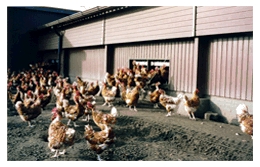 Popholes allow hens access to the free-range area or to a covered veranda. They are distributed along the entire side of the hen house to allow all hens easy access to free range or covered veranda. The number of popholes is usually related to the number of hens in the house. In some cases instead of using popholes farmers simply open the doors of the henhouse to enable hens to go outside.
Popholes allow hens access to the free-range area or to a covered veranda. They are distributed along the entire side of the hen house to allow all hens easy access to free range or covered veranda. The number of popholes is usually related to the number of hens in the house. In some cases instead of using popholes farmers simply open the doors of the henhouse to enable hens to go outside.
2.1.10 Lighting
In practice photoperiod length is usually between 12 and 17 hours in layers, often increasing as the hens increase in age (for gonadal stimulation). Good production results can also be achieved with intermittent photoperiods (alternating short periods of light and darkness).
Light intensity necessary to keep a normal laying rate is 5 to 7 lux (Sauveur, 1988; Lewis and Morris,1999). Morris (2004) showed a photoperiodic threshold at around 2 lux, but suggested that slightly higher values are sensible to recommend for laying houses because it is convenient for workers and allows for some variation in intensity in different parts of the house). Light intensities well over 10 lux are usually avoided to prevent serious feather pecking.
An even light distribution is desirable to minimise problems such as floor eggs, pecking or smothering. Where there is natural light, apertures are often shaded or baffled to avoid direct sunlight and thus arranged in such a way that light is distributed evenly within the accommodation.
For the first few days after housing light may be fairly bright. Later the light intensity should be such as to prevent health and behavioural problems.
Management components
2.2.1 Inspection systems (catwalks, trolleys)
When multi-tier systems (both cages and alternatives) are present inspection and removal of birds in some tiers may be difficult. Catwalks between tiers enable keepers to readily service birds. Trolleys or stepladders may also be used. These may be trolleys attached to one or more sides of the cage system, or free standing ones that pass through the aisles. They may be equipped with containers for various materials.
2.2.2 Manure removal and storage
Frequent removal of manure from the henhouse and manure drying reduces the ammonia concentration in the air.
Manure removal is generally mechanised using scrapers or belts. They may have air-drying systems ventilating and drying the manure. Air temperature can be increased with heating systems and/or heat exchangers using the heat of outgoing ventilation air to heat incoming fresh air.
A removal system is used to convey the manure from the end of the building to the container or storage area. Alternatively the storage may be underneath the building in a separate room. Another approach is to store the manure in a pit underneath a perforated floor or below the house
where it is stored and subsequently processed or spread on the land.
2.2.3 System Management
The effect of systems and system components on the welfare of hens is not only dependent on the design, but also on the management of the system. Even the best design can lead to failures if the management is not adequate. It is hard to give strict definitions of proper management. Some general aspects are given.
REARING OF PULLETS:
- success in the laying period will greatly depend on the housing and management in the rearing period. To facilitate a smooth start to the laying period it is advised to rear the pullets in a system that is similar to the system they will be housed in during the laying period and to transfer them into it well before onset of lay.
- feed and light management of the pullets will influence the production results later in life. Stimulation too early may lead to more egg laying problems. As the challenges hens meet in the laying period are different for cage systems and alternative systems, the rearing management should be focussed on the demands of the laying period.
FEED AND WATER:
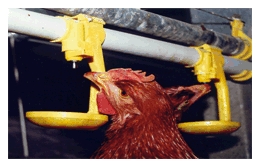 Access to feed and water is influenced by: the distribution of feeders and drinkers in the system, the frequency of supply, the amount of water and feed available per batch.
Access to feed and water is influenced by: the distribution of feeders and drinkers in the system, the frequency of supply, the amount of water and feed available per batch.- Good distribution of feeders and drinkers is important to allow easy access for all birds.
LIGHT:
- The type of light source in combination with the positioning of the lights defines the distribution of light in the house. The location of the lights should be chosen to minimize the amount of shaded areas and thus the risk of floor eggs.
- The management of daylength (the pattern of light and darkness) will influence the onset of lay and affect the distribution of the hens within the system. A proper dawn and dusk period will enable hens to perch and will minimise floor eggs.
- Different light intensities may be applied in different parts of the systems, e.g. the litter area may be slightly lighter than other areas in the system. Nestboxes usually have lower light levels to create a shaded place for the birds to lay eggs.
PERCHES:
- The use of perches will depend on several factors, including genotype, rearing experience, the available perch length and the provision of an acceptable perch position.
- Perch position can also influence soiling of the hens and litter, calmness of the flock and (vent)pecking.
POPHOLES:
The height of the popholes usually allows easy passage of the hens. Having more popholes or popholes with sufficient width can prevent one of a few hens blocking the passage of other hens. Large popholes not only give hens access to the outside area, but may also enable other animals to
enter the house. Vertical bars spaced about 15 cm apart are sometimes used to prevent larger animals entering. The large openings may influence the climate in the house, especially in case of cold, wet and windy weather. If they open onto wet muddy areas, the litter within the house can quickly deteriorate. Popholes may be protected e.g. with a small roof above, slats or free draining material around them and baffles to minimise wind entry.